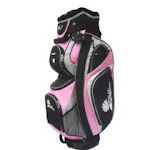Buying a golf putter that’s right for you isn’t easy. You need to do your homework to find one that fits both your golf budget and your golf game, which means learning the different types of golf putters and golf clubheads available and their advantages. But doing your homework is worth it because having a good golf putter, as I often say in my golf lessons, shaves strokes off your golf handicap.
The key considerations when looking for a golf putter are price, quality, type, golf clubhead, and alignment system. Face insert, loft, and hosel are additional considerations. I’ve talked about these considerations in my golf tips, but here’s some additional information about them.
Price/Quality
Prices for golf putters range from $30 to $250 or more. Usually, the higher the price, the better the quality. While buying quality is nice, you don’t have to overspend to find the right golf putter. Consider putters from all price ranges before investing, but look for one that feels right to you and fits your budget. That can take time, but if you look hard enough, you just might find a good but inexpensive golf putter that will work as well as an expensive one.
Type
Golf putter types include traditional, belly, and long. Most players use a traditional golf putter, which allows for the best blend of feel and mechanical precision. Traditional putters demand “quiet” wrists, a big hurdle for some. They also affect golfers with bad backs. Hence, the increased use of the belly and the long putters. Nevertheless, they’re easier to master than the belly or long putters, which is why I cover them in my golf lessons.
The belly golf putter provides a third point of contact - the abdomen— between the putter and the player, the other two being your hands. This golf putter adds stability and balance to your golf stroke. The belly putter enables a golfer to control his wrist action and assume a near perfect position for golf putting, but the club’s longer shaft and generally thicker grip inhibits feel and feed back. Distance control is also a problem.
Long golf putters provide a stroke with a true pendulum arc, are great for players with bad backs, and completely eliminate wrist action, but they inhibit feel, feed back, and distance control even more than belly putters. Many players consider them the “last refuge” for players with highly active wrists, but you’ll often see them used by pros on the tour who are having trouble with their golf putting.
Clubhead
Golf putters come with blade, cavity back, and mallet clubheads. A blade has the clubhead’s weight distributed to the heel or bottom of the putter, leaving a thin top line to view when addressing the ball. It is harder to control than a cavity back or a mallet. A cavity back features a hollow area in the middle of the club- the golf clubhead’s back, creating a larger sweet spot. A golf mallet putter is bigger than traditional putter’s clubhead but its shape varies widely. Also check out the face-balanced and the heel-toe-weighted mallets, which promote a straight stroke and minimize mishits.
Alignment System
Aligning the golf putter to the hole is critical to sinking the putt, as I emphasize in my golf lessons. If the putter isn’t lined up properly, the ball won’t go in regardless of how well it’s hit. Try finding a golf putter with a visual aid to help you line up the club with the hole, one that you feel comfortable and confident with. There’s no research showing that one alignment system is better than another, so choose one that feels right to you. But make sure you buy a golf putter that has one.
Additional Considerations
Face inserts are available in a variety of materials including metal, rubber, ceramic, plastic, glass, and wood. They provide more feel and feedback, better define a club’s sweet spot, and increase heel-toe weighting. They are nice but not necessary, which I’ve often mentioned in my golf tips.
Believe it or not, golf putters come with about 4 degrees of loft, which keeps the golf ball from bouncing when struck. Most golfers use a putter with standard loft because their hands are vertical to the ball at impact. Loft can be added or taken away depending on where your hands are when you hit the ball.
A golf putter with an offset shaft or hosel appeals to many recreational golfers. The offset helps them address the ball with their forward eye over the ball and a good line of sight to the hole. More importantly, the offset helps them keep their hands ahead of the ball when putting, increasing accuracy.
Golf instruction aside, a good golf putter is critical to improving your golf handicap. But choosing a putter is mostly a matter of feel, so look for one that feels comfortable. If you find a golf putter you think fits your game, try it before purchasing it. Some golf stores have small putting greens that allow you to test a putter. Others will let you take the putter home to test. By all means, do so. It’s the only way to really know.
Putting Secrets Revealed $37.00
Jack Moorehouse is the author of the best-selling book “How To Break 80 And Shoot Like The Pros.” He is NOT a golf pro, rather a working man that has helped thousands of golfers from all seven continents lower their handicap immediately. He has a free weekly newsletter with the latest golf tips, golf lessons and golf instruction.
Article Source: Adapted from http://EzineArticles.com/?expert=Jack_Moorehouse















